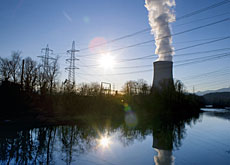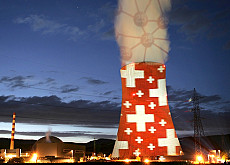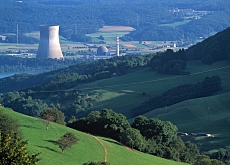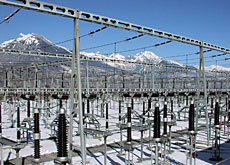Nuclear or gas power needed to keep lights on

Switzerland could be in the dark from 2020 if it does not act now to prevent a shortfall in power production.
In order to prevent the worst-case scenario from coming true, the government is faced with the tough choice of putting new nuclear power plants online or investing in carbon dioxide emitting gas-fired stations.
Energy policy can be tricky. Experts agree that there is no environmentally-friendly, cheap and risk-free method to produce electricity on a large scale.
As far as nuclear power is concerned, they rate the risk of a reactor meltdown such as the one that occurred in the Three Mile Island complex in the United States in 1979 as extremely low.
It is still debated today whether released radiation caused increased rates of cancer among the local American population.
But accidents can also take place in gas-fired power plants. In 2004, an explosion at a station in Algiers caused deaths and casualties. There were also accidents at this type of plant Tbilisi, Georgia in 1995 and six years later in the German town of Duisburg. However the effects in each case were limited to the station itself.
Storage
Nuclear waste poses another threat since it must be stored for thousands of years. A new type of final storage deep underground has been designed and facilities are already under construction in Finland and Sweden.
In June 2006, the Swiss government decided that the disposal of high-level waste should also be possible at home. Two areas are currently being discussed as possible locations for such storage facilities – the winegrowing region north of Zurich and the Bözberg area halfway between the Swiss financial capital and Basel to the northwest.
There is seems to be no obvious solution for disposal of the CO2 which is emitted in large quantities by gas-fired plants.
While it is possible to separate the greenhouse gases chemically or through cooling traps, how and where the waste can then be permanently stored in isolation from the biosphere is unclear.
Trials are taking place to pump CO2 back into empty coalmines or abandoned oil bore holes under the sea in a process known as carbon sequestration.
Supply
Although Switzerland has to import the fuel for its nuclear reactors, the fuel can be stockpiled and stored in a small space for many years. The nuclear sector is not worried about possible short-term interruptions in supply or attempts at extortion on the part of the producing countries.
Things also look quite secure for long term supply of reactor fuel. The guaranteed uranium supply covers world needs for the next 70 years and on top of that there are estimated reserves for more than 270 years in phosphate stocks, granite and seawater uranium.
With the use of breeder technology and stocks of thorium – considered an alternative to uranium – a virtually unlimited potential for reactor fuel has been made available.
Natural gas is also likely to last a long time. The known reserves today should be enough to last another 70 years. Rising prices will make gas exploration lucrative and new supply fields will probably be discovered. Methane, both as a biomass or chemically extracted, is also an option.
The situation in relation to short-term security of gas supply is less positive. The disputes between Russia and its neighbours over pipelines have recently shown again how fragile deliveries can be when energy has to be transported across land borders.
swissinfo, Ulrich Goetz
In 2005, power from Switzerland’s Gösgen nuclear station cost 4.34 cent per kilowatt-hour (kWh), including provision for final shut down and waste disposal.
On the more expensive side, NOK Limited, which runs power stations in northeastern Switzerland, calculated power costs of 11.43 cent per kWh for natural gas, based on gas prices in October 2006 and including CO2 charges.
In a combined cycle gas turbine plant, such as those planned for Switzerland, power is produced in two stages.
The gas is ignited under pressure in the combustor where 1300 degree fumes drive a turbine like in an airplane.
The 550 degree emissions then generate steam in heat exchangers which in turn drive a steam turbine.
The gas and steam turbines are each connected to a power generator. The excess heat is dealt with in the same way as in nuclear stations.
A nuclear power plant is driven by energy that is released through the fission or splitting of an atomic core.
The isotope uranium-235 is the material that is normally split or “burned”. The atomic fuel must contain around 3 per cent of this isotope for the atomic reaction to work.
The process is supported by water that serves as a moderator and also acts as a conductor for the energy produced.
This energy is delivered to heat exchangers where steam is generated in a second cycle which then drives turbines and power generators.
The excess heat is released into the environment into a river, as in Beznau and Mühleberg, or through cooling towers, as in Gösgen und Leibstadt.

In compliance with the JTI standards
More: SWI swissinfo.ch certified by the Journalism Trust Initiative



You can find an overview of ongoing debates with our journalists here. Please join us!
If you want to start a conversation about a topic raised in this article or want to report factual errors, email us at english@swissinfo.ch.